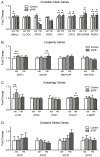Early Time-Restricted Feeding Improves 24-Hour Glucose Levels and Affects Markers of the Circadian Clock, Aging, and Autophagy in Humans
- PMID: 31151228
- PMCID: PMC6627766
- DOI: 10.3390/nu11061234
Early Time-Restricted Feeding Improves 24-Hour Glucose Levels and Affects Markers of the Circadian Clock, Aging, and Autophagy in Humans
Abstract
Time-restricted feeding (TRF) is a form of intermittent fasting that involves having a longer daily fasting period. Preliminary studies report that TRF improves cardiometabolic health in rodents and humans. Here, we performed the first study to determine how TRF affects gene expression, circulating hormones, and diurnal patterns in cardiometabolic risk factors in humans. Eleven overweight adults participated in a 4-day randomized crossover study where they ate between 8 am and 2 pm (early TRF (eTRF)) and between 8 am and 8 pm (control schedule). Participants underwent continuous glucose monitoring, and blood was drawn to assess cardiometabolic risk factors, hormones, and gene expression in whole blood cells. Relative to the control schedule, eTRF decreased mean 24-hour glucose levels by 4 ± 1 mg/dl (p = 0.0003) and glycemic excursions by 12 ± 3 mg/dl (p = 0.001). In the morning before breakfast, eTRF increased ketones, cholesterol, and the expression of the stress response and aging gene SIRT1 and the autophagy gene LC3A (all p < 0.04), while in the evening, it tended to increase brain-derived neurotropic factor (BNDF; p = 0.10) and also increased the expression of MTOR (p = 0.007), a major nutrient-sensing protein that regulates cell growth. eTRF also altered the diurnal patterns in cortisol and the expression of several circadian clock genes (p < 0.05). eTRF improves 24-hour glucose levels, alters lipid metabolism and circadian clock gene expression, and may also increase autophagy and have anti-aging effects in humans.
Keywords: circadian rhythms; circadian system; intermittent fasting; meal timing; time-restricted feeding.
Conflict of interest statement
The authors declare no conflict of interest. The funders had no role in the design of the study; in the collection, analyses, or interpretation of data; in the writing of the manuscript; or in the decision to publish the results.
Figures






References
Publication types
MeSH terms
Substances
Grants and funding
LinkOut - more resources
Full Text Sources
Medical
Research Materials
Miscellaneous

